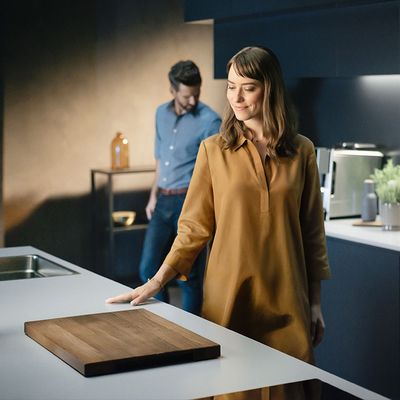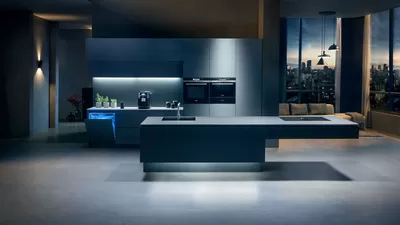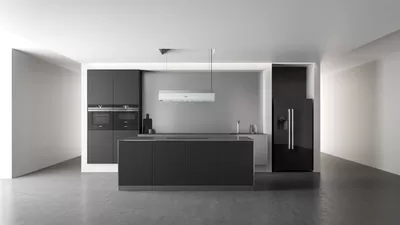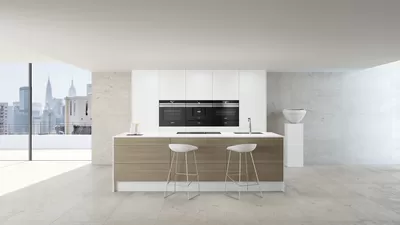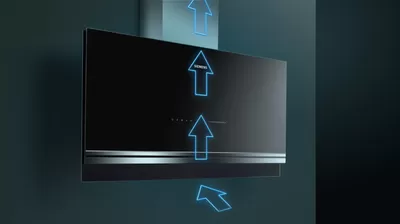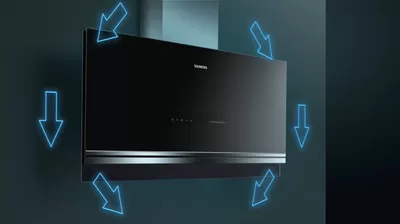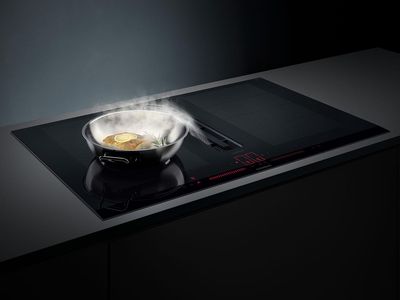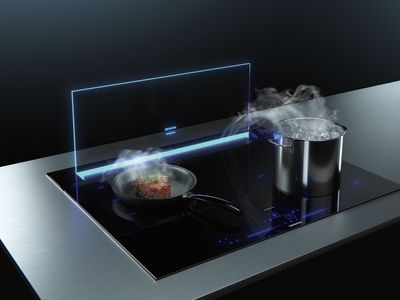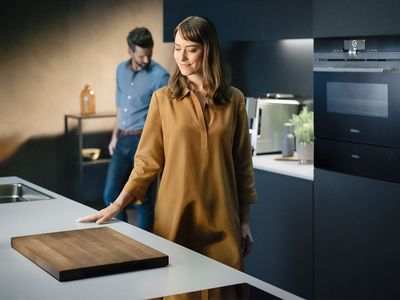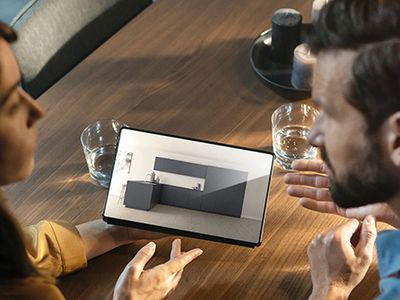Kitchen Planning Advice - Cooker Hoods
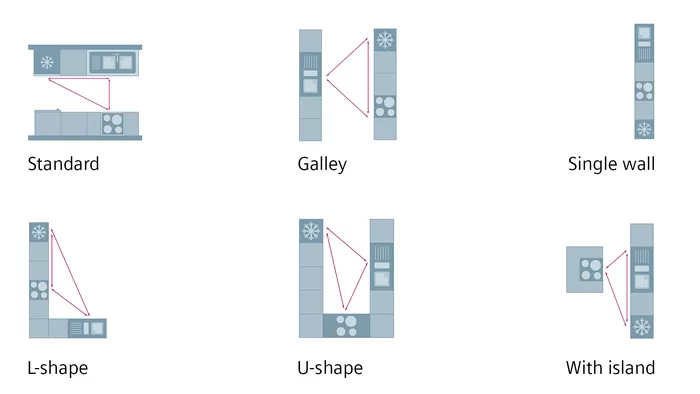
Efficient kitchen planning based on the work triangle concept.
The kitchen work triangle is a key kitchen layout design principle. The work triangle consists of the three most frequently used work areas in the kitchen:
- Washing (dishwasher and kitchen sink)
- Cooking (cooker/oven, hob) and
- Refrigerating/freezing (fridge and freezer)
The closer these facilities are to one another, the more efficiently you can move around your kitchen – and everything you need will be within easy reach.
Please note that the work triangle concept cannot be used in single-file/one-way galley kitchens because everything is in line along one wall. For this type of layout, it is important to arrange the work areas in the correct order, with the dishwashing area in the middle.

The right position.
For an ergonomic work station, the position of cabinets and appliances also play a key role alongside the work triangle. Frequently used utensils and appliances should be within easy reach (80 to 160 cm above the floor). This means that you avoid having to frequently bend down or reach for a stepladder, thereby reducing your risk of accidents and injury.
When planning your base cabinets, from an ergonomic perspective it is best to opt for drawer solutions. This way, you can see everything simply by looking down and do not have to bend down or kneel quite so often in order to get to the back of the cupboard. The same applies to ovens. If you are unable to install your oven at eye level because the only space available for it is underneath the work surface, a good alternative is to use telescopic shelf rails or an "oven carriage" (drawer-like door).
The height of the worktop is another key factor that can make cooking easier if you get it right. Always base the height of the work surface on the height of the person who is going to be doing most of the cooking. Ergonomically speaking, the ideal height for the hob is 20 cm below elbow height, or a height between 85 and 95 cm.
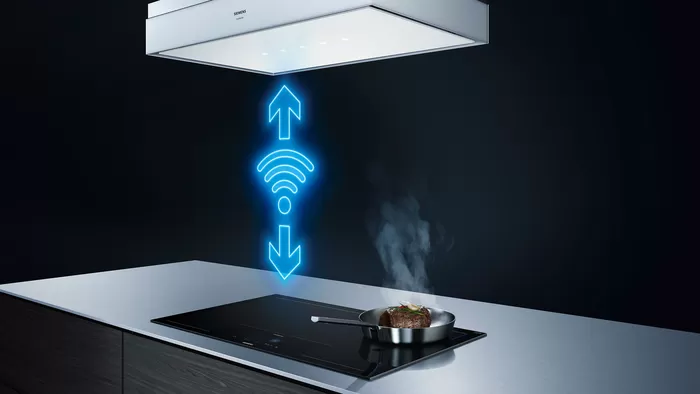
Smart kitchen with Home Connect.
In some kitchens, the only space available to install the oven is in a base cabinet. This makes for sub-optimal ergonomics, meaning your oven will not be as easy to use as it could be. The answer to this comes in the form of Siemens ovens with Home Connect: Home Connect allows you to control your oven from your smartphone, or alternatively, by means of voice control using Amazon Alexa or Google Assistant. So now, the only time you will need to bend down is when you are putting your food into the oven or taking it out again.
The Home Connect app also allows you to control additional household appliances from your smartphone for yet more flexibility. For example, a camera in the fridge allows you to quickly check what you already have at home before you go shopping so that you don't end up making any unnecessary purchases. Another thing you can do quite easily is have your hob and extractor hood communicate with one another directly to achieve optimal steam extraction. Home Connect opens up a whole load more possibilities with your household appliances and makes your life a whole load easier. Discover the many possibilities of Siemens household appliances with Home Connect here.
Attractive feature or seamlessly integrated – appliance design that caters to your tastes.
When people plan kitchens, their primary focus is often the kitchen layout and the colour and materials of the cabinets. But it is important not to forget how much of an impact the kitchen appliances can have on the look of your kitchen.
Whatever you choose, Siemens household appliances are designed to work well together so that you can have virtually any combination of appliances and be sure that they will perfectly complement one another.
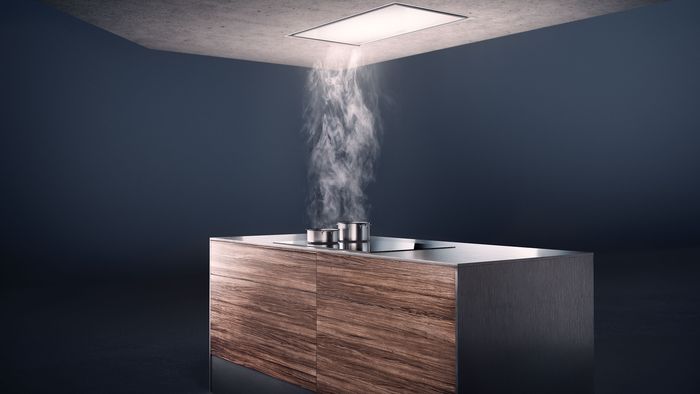
The right extraction solution.
To make finding the right solution for your living situation among our wide range of extraction systems more manageable, we have gathered all the most important information about extractor hoods in one place for you.
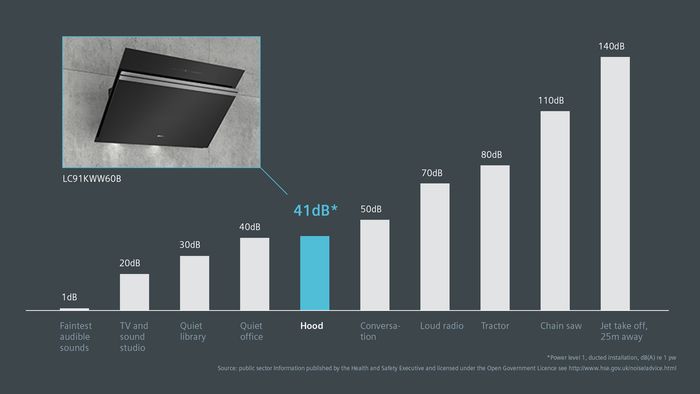
Noise levels.
There's nothing better than getting together with friends to cook, eat good food and enjoy each other's company. If you have a loud extraction system, it can quickly end up becoming too overbearing. Siemens' extractor hoods combine maximum extraction performance with minimal noise. State-of-the-art technology and high-quality workmanship prevent vibration and friction. The fins in the motorised fan are shaped so as to produce virtually no noise. And thanks to a special, patented sound insulation, our best extractor hoods are incredibly quiet, running at as little as 37 dB (equivalent to 51 dB (A) re 1 pW) – that's the kind of noise levels you would find in a quiet office environment. So now, you can happily chat away with your friends with zero interruptions.
The right filter.
All extraction solutions use filters to eliminate steam and odours. There are a number of different filter types, and these affect the performance of your extractor hood:

Standard filter Effective activated carbon filter. |

CleanAir Plus filter CleanAir Plus filter for optimal odour reduction coupled with reduced noise. |
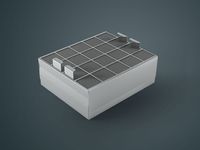
Long-life filter Like the CleanAir Plus filter, offers improved odour reduction coupled with reduced noise and can easily be regenerated in the oven every few months, saving you money in the long term. |
|
| Odour reduction | Over 60% | Over 90% | Up to 95% (over 80% when installed without a chimney) |
| Service life | 6-12 months | 12-18 months | 10 years |
| Benefits |
|
|
|
| Installation | In the extractor hood, behind the grease filter |
Extra module required for installing the CleanAir Plus filter
|
|
| Is it possible to install wall-mounted extractor hoods without a chimney? | Yes (inclined and flat extractor hoods only) | Possible for inclined and vertical extractor hoods as of 12/2020 | Yes (inclined and flat extractor hoods only) |
Air recirculation (ductless) or air exhaust (ducted)?
For optimal performance, we recommend a ducted, air exhaust extractor hood, which conducts the air directly to the outside of the building. However, this option is only possible if the necessary ducting was put in when the house was built. If this is not a possibility for you, most Siemens extraction solutions can be installed in recirculation, or ductless, mode, whereby the air first passes through a metal filter to remove grease and then passes through a carbon filter to remove odours, before being recirculated to the kitchen. The extraction performance of ductless systems, which recirculate air to the room, is slightly inferior to ducted systems, but it is nevertheless still very good. On the other hand, ductless, air recirculation hoods actually have an advantage in terms of energy efficiency over ducted, air exhaust solutions: Cool air will remain in the building in summer, and warm air will not be conducted outside during the winter months.

The right distance between hood and hob.
To ensure that your extractor hood functions correctly and that you can cook uninterrupted, it is important that you allow the correct clearance between the hood and the hob when installing the hood (if you are not using an extraction solution that is integrated into the hob). It is therefore advisable to install the extractor hood 55 - 65 cm above the hob. If you have a gas cooker, the clearance should be 65 - 75 cm.
Are you on the tall side? If so, our inclined extractor hoods and ceiling extractor hoods are the perfect solutions for that extra bit of headroom. Alternatively, you could opt for a hob with an integrated extraction system.
Hobs with integrated extraction system.
Hobs with an integrated extraction solution not only combine two appliances into one, but they also maximise both the available headroom and the amount of freedom you have to create exactly the kitchen you want. Choose from one of two worktop-mounted systems offered by Siemens: inductionAir Plus or glassDraft Air.
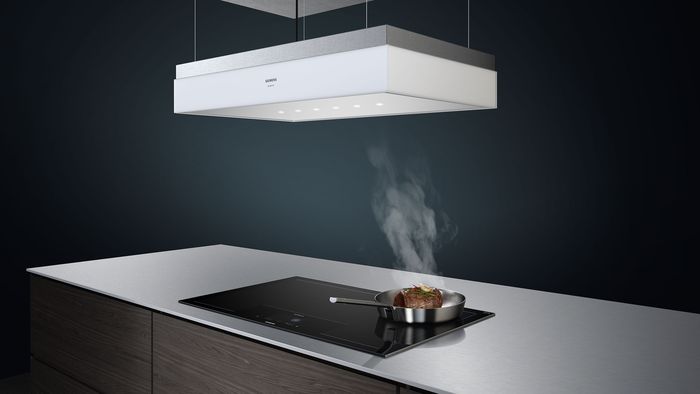
The specific aspects of an island solution.
If you want to install the hob on an island in your open-plan kitchen, you can choose between a hob with an integrated extraction system or an island extractor hood. Island extractor hoods are connected to the ceiling by means of a ventilation duct and can be installed directly above the kitchen island. Due to the flexibility that ceiling mounting offers, they can be used in most rooms. Even sloped ceilings pose no problem for island extractor hoods thanks to a special installation kit.
You also have the option to install the ceiling extractor hood directly on the ceiling, which gives you a clear line of sight. With this variant, there are a few points to note. If you want to use an air exhaust system with your hood, this is only actually possible if the cooking vapours can be conducted outside directly through the ceiling. For effective extraction, the clearance between the hob and the hood must be no more than 155 cm. It is therefore important that you take into account the ceiling height when planning your extraction system. In addition, you will only be able to control the ceiling extractor hood using a remote control, and it will be more difficult to clean and replace the filters. You can overcome these limitations by opting for the varioLift, which can be lowered. This extractor hood is also installed directly on the ceiling and can be lowered as required for optimal performance. The varioLift is suitable for ceiling heights of up to 3.5 metres.

